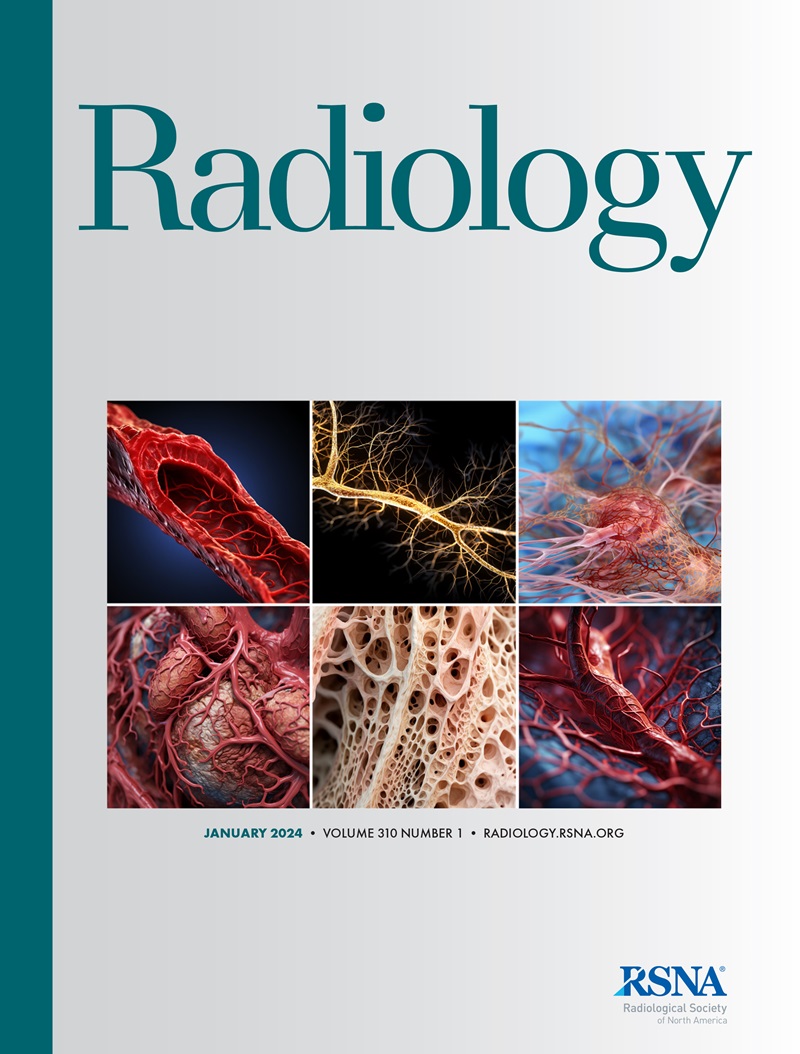Upasana U Bharadwaj, John A Lynch, Gabby B Joseph, Zehra Akkaya, Michael C Nevitt, Nancy E Lane, Charles E McCulloch, Thomas M Link
下载PDF
{"title":"Intra-articular Knee Injections and Progression of Knee Osteoarthritis: Data from the Osteoarthritis Initiative.","authors":"Upasana U Bharadwaj, John A Lynch, Gabby B Joseph, Zehra Akkaya, Michael C Nevitt, Nancy E Lane, Charles E McCulloch, Thomas M Link","doi":"10.1148/radiol.233081","DOIUrl":null,"url":null,"abstract":"<p><p>Background At least 10% of all patients with knee osteoarthritis (OA) undergo treatment with injectable corticosteroids or hyaluronic acid (HA). Although both have been shown to help with symptomatic pain relief, their long-term effects on knee OA progression remain inconclusive. Purpose To investigate the association between intra-articular knee injections, specifically corticosteroids and HA, and OA progression using a detailed whole-joint semiquantitative MRI evaluation and clinical outcomes for a period of 2 years. Materials and Methods This secondary analysis uses data from the Osteoarthritis Initiative (OAI), a multicenter, longitudinal, prospective study (February 2004 to January 2015). Participants who received a reported injection of corticosteroid or HA and propensity-score-matched controls (on age, sex, body mass index [calculated as weight in kilograms divided by height in meters squared], and clinical variables) were analyzed. Using the Whole-Organ MRI Score (WORMS) system for cartilage, bone marrow lesions, and meniscus, 3-T MRI performed at the time of injection, 2 years prior, and 2 years after were semiquantitatively graded. Postinjection progression was quantified using WORMS difference between time of injection and the 2-year follow-up. Associations with injection type were analyzed using repeated measures of analysis of covariance. Results There were 210 participants analyzed (mean age, 64 years ± 7.9 years [SD]; 126 female participants). Corticosteroids were associated with greater WORMS progression compared with controls (mean difference, 0.39; 95% CI: 0.05, 0.75; <i>P</i> = .02) and HA (0.42; 95% CI: 0.01, 0.84; <i>P</i> = .04). HA was associated with decreased WORMS progression compared with the injection-concurrent time frame (mean difference, -0.42; 95% CI: -1.34, -0.28; <i>P</i> = .003). Both corticosteroids (mean difference in Western Ontario and McMaster Universities Osteoarthritis Index scores, -5.20; 95% CI: -6.91, -3.48; <i>P</i> = .001) and HA injections (-2.15; 95% CI: -4.42, -0.13; <i>P</i> = .04) were associated with reduced pain after injection. Conclusion Corticosteroid injections were associated with higher OA progression than HA injections and controls, whereas HA was associated with decreased progression at MRI for up to 2 years after injection. ClinicalTrials.gov Identifier: NCT00080171 © RSNA, 2025.</p>","PeriodicalId":20896,"journal":{"name":"Radiology","volume":"315 2","pages":"e233081"},"PeriodicalIF":12.1000,"publicationDate":"2025-05-01","publicationTypes":"Journal Article","fieldsOfStudy":null,"isOpenAccess":false,"openAccessPdf":"https://www.ncbi.nlm.nih.gov/pmc/articles/PMC12127947/pdf/","citationCount":"0","resultStr":null,"platform":"Semanticscholar","paperid":null,"PeriodicalName":"Radiology","FirstCategoryId":"3","ListUrlMain":"https://doi.org/10.1148/radiol.233081","RegionNum":1,"RegionCategory":"医学","ArticlePicture":[],"TitleCN":null,"AbstractTextCN":null,"PMCID":null,"EPubDate":"","PubModel":"","JCR":"Q1","JCRName":"RADIOLOGY, NUCLEAR MEDICINE & MEDICAL IMAGING","Score":null,"Total":0}
引用次数: 0
引用
批量引用
Abstract
Background At least 10% of all patients with knee osteoarthritis (OA) undergo treatment with injectable corticosteroids or hyaluronic acid (HA). Although both have been shown to help with symptomatic pain relief, their long-term effects on knee OA progression remain inconclusive. Purpose To investigate the association between intra-articular knee injections, specifically corticosteroids and HA, and OA progression using a detailed whole-joint semiquantitative MRI evaluation and clinical outcomes for a period of 2 years. Materials and Methods This secondary analysis uses data from the Osteoarthritis Initiative (OAI), a multicenter, longitudinal, prospective study (February 2004 to January 2015). Participants who received a reported injection of corticosteroid or HA and propensity-score-matched controls (on age, sex, body mass index [calculated as weight in kilograms divided by height in meters squared], and clinical variables) were analyzed. Using the Whole-Organ MRI Score (WORMS) system for cartilage, bone marrow lesions, and meniscus, 3-T MRI performed at the time of injection, 2 years prior, and 2 years after were semiquantitatively graded. Postinjection progression was quantified using WORMS difference between time of injection and the 2-year follow-up. Associations with injection type were analyzed using repeated measures of analysis of covariance. Results There were 210 participants analyzed (mean age, 64 years ± 7.9 years [SD]; 126 female participants). Corticosteroids were associated with greater WORMS progression compared with controls (mean difference, 0.39; 95% CI: 0.05, 0.75; P = .02) and HA (0.42; 95% CI: 0.01, 0.84; P = .04). HA was associated with decreased WORMS progression compared with the injection-concurrent time frame (mean difference, -0.42; 95% CI: -1.34, -0.28; P = .003). Both corticosteroids (mean difference in Western Ontario and McMaster Universities Osteoarthritis Index scores, -5.20; 95% CI: -6.91, -3.48; P = .001) and HA injections (-2.15; 95% CI: -4.42, -0.13; P = .04) were associated with reduced pain after injection. Conclusion Corticosteroid injections were associated with higher OA progression than HA injections and controls, whereas HA was associated with decreased progression at MRI for up to 2 years after injection. ClinicalTrials.gov Identifier: NCT00080171 © RSNA, 2025.
膝关节内注射和膝关节骨性关节炎的进展:来自骨关节炎倡议的数据。
背景:至少10%的膝骨关节炎(OA)患者接受注射皮质类固醇或透明质酸(HA)治疗。虽然这两种药物都有助于缓解症状性疼痛,但它们对膝关节OA进展的长期影响仍不确定。目的通过详细的全关节半定量MRI评估和为期2年的临床结果,研究膝关节内注射(特别是皮质类固醇和HA)与OA进展之间的关系。材料和方法本二次分析使用骨关节炎倡议(OAI)的数据,这是一项多中心、纵向、前瞻性研究(2004年2月至2015年1月)。接受皮质类固醇或透明质酸注射的参与者和倾向评分匹配的对照组(年龄、性别、体重指数[以体重公斤除以身高米的平方计算]和临床变量)进行分析。使用全器官MRI评分(WORMS)系统对软骨、骨髓病变和半月板进行评分,在注射时、注射前2年和注射后2年进行3-T MRI半定量分级。注射后的进展用注射时间和2年随访的WORMS差异来量化。使用协方差分析的重复测量来分析与注射类型的关联。结果共纳入210例受试者(平均年龄64岁±7.9岁[SD];126名女性参与者)。与对照组相比,皮质类固醇与更大的蠕虫进展相关(平均差异为0.39;95% ci: 0.05, 0.75;P = .02)和HA (0.42;95% ci: 0.01, 0.84;P = .04)。与注射同期相比,HA与蠕虫进展减少有关(平均差值为-0.42;95% ci: -1.34, -0.28;P = .003)。两种皮质激素(安大略省西部大学和麦克马斯特大学骨关节炎指数得分的平均差异为-5.20;95% ci: -6.91, -3.48;P = .001)和HA注射(-2.15;95% ci: -4.42, -0.13;P = .04)与注射后疼痛减轻相关。结论:皮质类固醇注射比HA注射和对照组与更高的OA进展相关,而HA在注射后2年内与MRI进展降低相关。ClinicalTrials.gov标识符:NCT00080171©RSNA, 2025。
本文章由计算机程序翻译,如有差异,请以英文原文为准。

 求助内容:
求助内容: 应助结果提醒方式:
应助结果提醒方式:


